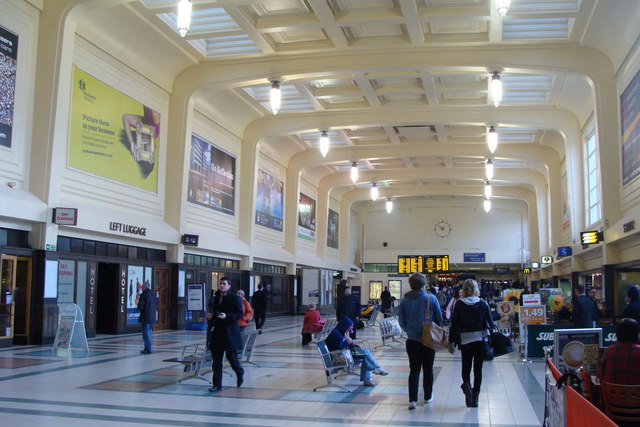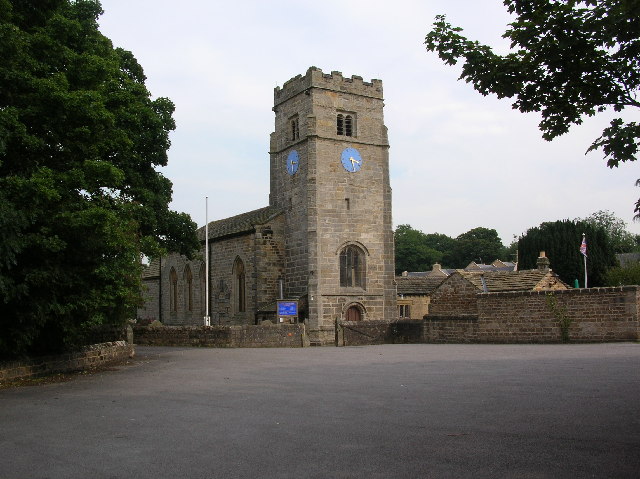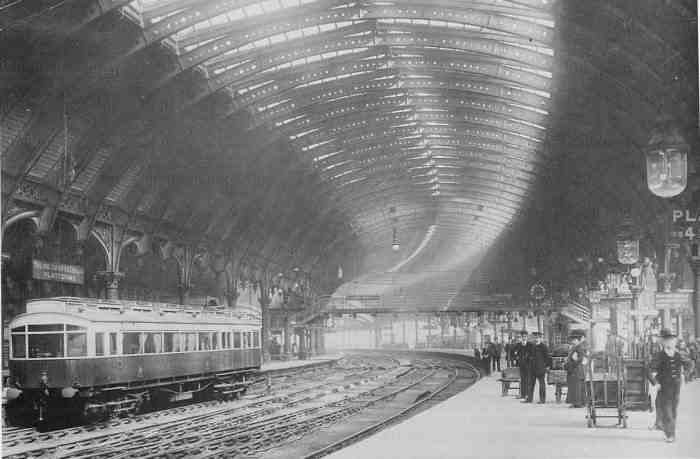|
Weeton Railway Station
Weeton railway station serves the villages of Weeton and Huby in North Yorkshire, England. It is located on the Harrogate Line north of Leeds and operated by Northern who provide all passenger train services. History The Leeds and Thirsk Railway was authorised in 1845, and built in stages. The section between and ''Weeton'' opened on 1 September 1848. On 9 July 1849, the final section of the original L&TR main line was formally opened, between Weeton and Leeds. The station at Weeton was described as ''Weeton for Ormscliff Crags'' in some timetables. Facilities The station is unstaffed, but has ticket machines in place to allow intending passengers to buy prior to boarding the train. There are only basic shelters on each platform, but there are passenger information screens in place and a public address system to provide train running information. Neither platform is DDA-compliant, as the Leeds one has steps to it and access to the Harrogate one is via a steep pathway. ... [...More Info...] [...Related Items...] OR: [Wikipedia] [Google] [Baidu] |
Huby, Harrogate
Huby is a village in the Harrogate district of North Yorkshire, England about five miles south-west of Harrogate. The village is on the A658 between Otley and Harrogate. It is served by Weeton railway station on the line which links Leeds with Harrogate. A rocky outcrop known as Almscliffe Crag is about one mile north-west of the village; it is formed from millstone grit and is very popular with climbers and boulderers. The village has a Methodist chapel. The Atkinson family, who lived in the village, are the focus of a 1978 book by Colin Gordon. It includes a family tree beginning with Henry Atkinson (1823–92) and Ellen Backhouse (1827–1908) along with many illustrations, rescued from photographic plates found on a market stall. The village is also the subject of a booklet by Joan Coombs. The first mention of a post office in the village was in 1888. A telegram Telegraphy is the long-distance transmission of messages where the sender uses symbolic co ... [...More Info...] [...Related Items...] OR: [Wikipedia] [Google] [Baidu] |
Leeds City Railway Station
Leeds railway station (also known as Leeds City railway station) is the mainline railway station serving the city centre of Leeds in West Yorkshire, England. It is the fourth-busiest railway station in the UK outside London (as of March 2020). It is located on New Station Street to the south of City Square, at the foot of Park Row, behind the landmark Queens Hotel. It is one of 20 stations managed by Network Rail. Leeds is an important hub on the British rail network. The station is the terminus of the Leeds branch of the East Coast Main Line (on which London North Eastern Railway provides high speed inter-city services to every half hour from the station) and is an important stop on the Cross Country Route between Scotland, the Midlands and South West England connecting to major cities such as Birmingham, Glasgow, Edinburgh, Derby, Bristol, Exeter, Plymouth and Penzance. There are also regular inter-city services to major destinations throughout Northern England including Manc ... [...More Info...] [...Related Items...] OR: [Wikipedia] [Google] [Baidu] |
Former North Eastern Railway (UK) Stations
A former is an object, such as a template, gauge or cutting die, which is used to form something such as a boat's hull. Typically, a former gives shape to a structure that may have complex curvature. A former may become an integral part of the finished structure, as in an aircraft fuselage, or it may be removable, being using in the construction process and then discarded or re-used. Aircraft formers Formers are used in the construction of aircraft fuselage, of which a typical fuselage has a series from the nose to the empennage, typically perpendicular to the longitudinal axis of the aircraft. The primary purpose of formers is to establish the shape of the fuselage and reduce the column length of stringers to prevent instability. Formers are typically attached to longerons, which support the skin of the aircraft. The "former-and-longeron" technique (also called stations and stringers) was adopted from boat construction, and was typical of light aircraft built until the adv ... [...More Info...] [...Related Items...] OR: [Wikipedia] [Google] [Baidu] |
DfT Category F2 Stations
The Department for Transport (DfT) is a department of His Majesty's Government responsible for the English transport network and a limited number of transport matters in Scotland, Wales and Northern Ireland that have not been devolved. The department is run by the Secretary of State for Transport, currently (since 25 October 2022) Mark Harper. The expenditure, administration and policy of the Department for Transport are scrutinised by the Transport Committee. History The Ministry of Transport was established by the Ministry of Transport Act 1919 which provided for the transfer to the new ministry of powers and duties of any government department in respect of railways, light railways, tramways, canals and inland waterways, roads, bridges and ferries, and vehicles and traffic thereon, harbours, docks and piers. In September 1919, all the powers of the Road Board, the Ministry of Health, and the Board of Trade in respect of transport, were transferred to the new minis ... [...More Info...] [...Related Items...] OR: [Wikipedia] [Google] [Baidu] |
Railway Stations In North Yorkshire
Rail transport (also known as train transport) is a means of transport that transfers passengers and goods on wheeled vehicles running on rails, which are incorporated in tracks. In contrast to road transport, where the vehicles run on a prepared flat surface, rail vehicles (rolling stock) are directionally guided by the tracks on which they run. Tracks usually consist of steel rails, installed on sleepers (ties) set in ballast, on which the rolling stock, usually fitted with metal wheels, moves. Other variations are also possible, such as "slab track", in which the rails are fastened to a concrete foundation resting on a prepared subsurface. Rolling stock in a rail transport system generally encounters lower frictional resistance than rubber-tyred road vehicles, so passenger and freight cars (carriages and wagons) can be coupled into longer trains. The operation is carried out by a railway company, providing transport between train stations or freight customer faciliti ... [...More Info...] [...Related Items...] OR: [Wikipedia] [Google] [Baidu] |
Pannal Railway Station
Pannal is a village in the Harrogate district of North Yorkshire, England. Historically part of the West Riding of Yorkshire, it is situated to the immediate south of Harrogate. Since 2016 it has formed part of the new civil parish of Pannal and Burn Bridge. The village is served by Pannal railway station on the Harrogate (Railway) Line between Leeds and York. History and etymology Pannal has been an important settlement for centuries. It developed in the middle of the former Knaresborough Forest and is believed to date back to the Bronze Age. Pannal was earlier known as Rossett, recorded in the Domesday Book of 1086 as ''Rosert'' (from the Old English ''hross hyrst'', meaning "horse wood"). Until the early 19th century the village of Pannal was part of Beckwith with Rossett, one of the eleven constableries within the Forest of Knaresborough, but the parish, which appears to have covered the same area as the constablery, was known as Pannal. The name Rossett sur ... [...More Info...] [...Related Items...] OR: [Wikipedia] [Google] [Baidu] |
Horsforth Railway Station
Horsforth railway station is a railway station in West Yorkshire, England. It is on the Harrogate Line north west of Leeds station and the final stop in the West Yorkshire Metro regulated area towards Harrogate. History The station, accessed from Station Road, serves Horsforth, Cookridge and Tinshill, and was opened in 1849. In 1969, staff were removed and all the buildings demolished, as part of the general retrenchment of railways in West Yorkshire at that time. However the goods shed still survives but it is incorporated in the larger DIY store. The nearby North Eastern Railway signal box survived until 2013. Growing traffic congestion in Leeds caused an increase in patronage from Horsforth in the 1990s, and in 2002-3, Horsforth station was extensively redeveloped to better cater for the greater number of passengers. New waiting rooms were built on both platforms, along with a ticket office on the Leeds (Up) platform, which opened on 16 July 2003. The car park was ex ... [...More Info...] [...Related Items...] OR: [Wikipedia] [Google] [Baidu] |
York Railway Station
York railway station is on the East Coast Main Line serving the city of York, North Yorkshire, England. It is north of and on the main line it is situated between to the south and to the north. , the station is operated by London North Eastern Railway. York station is a key junction approximately halfway between London and Edinburgh. It is approximately north of the point where the Cross Country and TransPennine Express routes via Leeds join the main line, connecting Scotland and the North East, North West, Midlands and southern England. The junction was historically a major site for rolling stock manufacture, maintenance and repair. In ''Britain's 100 Best Railway Stations'' by Simon Jenkins, the station was one of only ten to be awarded five stars. History The first York railway station was a temporary wooden building on Queen Street outside the walls of the city, opened in 1839 by the York and North Midland Railway. It was succeeded in 1841, inside the walls, ... [...More Info...] [...Related Items...] OR: [Wikipedia] [Google] [Baidu] |
Knaresborough Railway Station
Knaresborough railway station is a Grade II listed station serving the town of Knaresborough in North Yorkshire, England. It is located on the Harrogate Line west of York and is operated by Northern Trains, who provide all passenger train services. Location The station is located at the northern side of the Knaresborough Viaduct off Station Road to the south-west side of Knaresborough town centre. The station is within walking distance of the town centre and the western side of Knaresborough. History The East and West Yorkshire Junction Railway (E&WJR) was opened from York (Poppleton Junction) to a temporary terminus known as ''Hay Park Lane, Knaresborough'' on 30 October 1848. The E&WYJR was absorbed by the York and North Midland Railway on 1 July 1851. Three weeks later, with the completion of the stone viaduct crossing the River Nidd at Knaresborough on 21 July 1851, the temporary station was closed and a new ''Knaresborough'' station opened on the current site just bey ... [...More Info...] [...Related Items...] OR: [Wikipedia] [Google] [Baidu] |
Leeds Railway Station
Leeds railway station (also known as Leeds City railway station) is the mainline railway station serving the city centre of Leeds in West Yorkshire, England. It is the fourth-busiest railway station in the UK outside London (as of March 2020). It is located on New Station Street to the south of City Square, at the foot of Park Row, behind the landmark Queens Hotel. It is one of 20 stations managed by Network Rail. Leeds is an important hub on the British rail network. The station is the terminus of the Leeds branch of the East Coast Main Line (on which London North Eastern Railway provides high speed inter-city services to every half hour from the station) and is an important stop on the Cross Country Route between Scotland, the Midlands and South West England connecting to major cities such as Birmingham, Glasgow, Edinburgh, Derby, Bristol, Exeter, Plymouth and Penzance. There are also regular inter-city services to major destinations throughout Northern England including Manc ... [...More Info...] [...Related Items...] OR: [Wikipedia] [Google] [Baidu] |
Weeton Railway Station Entrance, August 2020
{{Geodis ...
Weeton is the name of various locations in England: *Weeton, East Riding of Yorkshire *Weeton-with-Preese, Lancashire *Weeton, North Yorkshire Weeton is a village and civil parish in the Harrogate district of North Yorkshire, England. The name is first attested in the Domesday Book of 1086 as ''Widetun(e)''/''Wideton(e)'' and seems to derive from Old English ''wiðig'' 'willow' and ' ... [...More Info...] [...Related Items...] OR: [Wikipedia] [Google] [Baidu] |
Ian Allan Publishing
Ian Allan Publishing was an English publisher, established in 1942, which specialised in transport books. It was founded by Ian Allan. In 1942 Ian Allan, then working in the public relations department for the Southern Railway at Waterloo station, decided he could deal with many of the requests he received about rolling stock by collecting the information into a book. The result was his first book, ''ABC of Southern Locomotives''. This proved to be a success, contributing to the emergence of trainspotting as a popular hobby in the UK, and leading to the formation of the company.Ian Allan…the man who launched a million locospotters ''The Railway Magazine'' issue 1174 February 1999 pages 20-27 The company grew from a small producer of books for train enthusiasts and spotters to a large transport publisher. Each year it published books covering subjects such as military and civil aviation, naval and maritime topics, buses, trams, trolleybuses and steam railways, including h ... [...More Info...] [...Related Items...] OR: [Wikipedia] [Google] [Baidu] |







